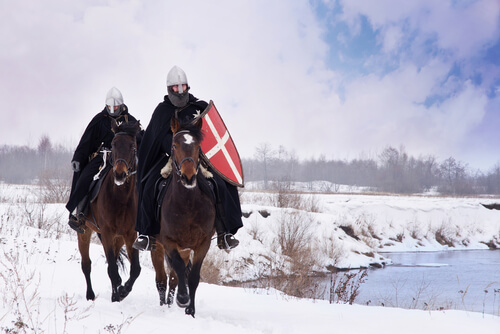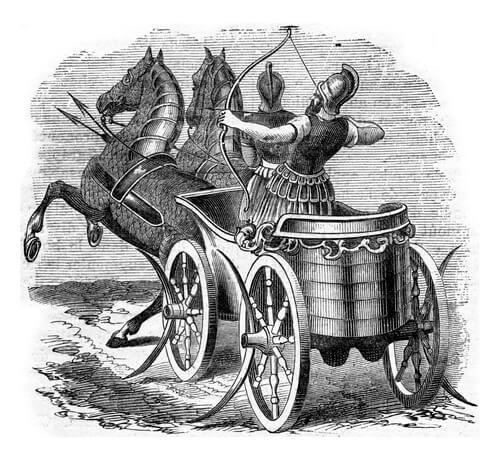Famous Horses in History

Throughout history, horses have been crucial to our evolution as individuals and as a society. Beyond their strength and physical beauty, their nobility is what has made them admirable and majestic companions. Next up, we’ll look at some of the famous horses in history and some fictional ones too.
7 famous horses in history and fiction
1. Bucephalus (Alexander the Great)
Bucephalus was the name of the most famous and beloved horse of Alexander the Great. It’s estimated that this noble equine lived from 335 BC to 326 BC. Its death would have occurred during the Battle of Hispades, in the present territory of Pakistan.
Some theories claim that his body was buried on the outskirts of Jhelum, in a town called Jalapur Sharif. However, there’s another hypothesis that says that Bucephalus rests in peace in Phalia, also located in Pakistan.
2. Marengo (Napoleon Bonaparte)
Marengo was the faithful companion of Napoleon Bonaparte, and was eternalized as one of the famous horses in world history. Its name was a tribute to the Battle of Marengo (Italy), from which the French imperial army emerged victorious.
Marengo carried the emperor in several historic battles, including Waterloo, Austerlitz, Jena, and Wagram. It’s estimated that it lived from 1793 to 1831; its skeleton is now preserved in London at the National Army Museum in Chelsea.
According to historical accounts, Napoleon was a great admirer of horses. More than 100 equines were recorded in his personal stable, most notably Marengo and the steeds White and Vizir.

3. The mare Babieca (El Cid)
Many of us probably know the story of the El Cid, but few know the story of his famous mare Babieca. The story goes that when El Cid was still a child, his stepfather took him to the stables of the monastery where they lived and asked his godson to choose the horse he liked best.
To everyone’s surprise, El Cid chose the ugliest and most humble equine in the stables. According to his stepfather, the horse (the mare, in fact) was a babieca (stupid, or a fool), as it possessed none of the attributes to be a great conqueror.
Nevertheless, history proved Cid’s wisdom and the merits of his great mare. Together they won numerous battles, and Babieca enjoyed great longevity, dying at the age of 40. The story of El Cid and Babieca reminds us that the true attributes aren’t in the physical attributes, but in the nobility of spirit.
4. Palomo (Simon Bolivar)
Palomo was the most famous horse of the liberator Simón Bolívar, one of the most important figures of South America. It’s said that the equine was given to Bolivar before the Battle of Boyaca, which took place in 1819, in the current territory of Colombia.
Since then, Palomo accompanied his heroic rider in all his national liberation campaigns. Currently, his horseshoes are exhibited with honor in the Mulaló Museum, located in the city of Tumbo, Colombia.
5. Pegasus (Zeus)
Pegasus is the famous winged horse of Zeus, a white stallion born, as the legend goes, from the blood spilled by Medusa. In addition to being a famous horse in Greek mythology and international fiction, Pegasus has been the only equine to ‘live’ among the gods of Olympus.

6. Rocinante (Don Quixote)
Rocinante is one of the famous horses in literature, which has also had representations in film and television. Its name derives from the word ‘rocín’, the name given to horses that used to do heavy work in the Spanish fields.
Unlike the great knights who chose noble names for their equines, our favorite hidalgo chose to call his companion Rocinante. More than for his appearance or lineage, Rocinante has been eternalized by his incomparable loyalty.
7. The Trojan Horse
Although not ‘flesh and blood’, the Trojan Horse is undoubtedly one of the most famous horses in history. This huge wooden equine was built by the Greeks and sent as a ‘gift of surrender’ to the Trojans.
As we know, it was a clever strategy to break through the massive walls of Troy. The wooden horse opened the gates for the Greek soldiers, who eventually won the battle and conquered the city. Since then, the Trojan Horse has been engraved in popular culture as a symbol of cunning (on the positive side), and treachery (on the negative side).
All cited sources were thoroughly reviewed by our team to ensure their quality, reliability, currency, and validity. The bibliography of this article was considered reliable and of academic or scientific accuracy.
- DreamWorks (s.f.). Spirit: Stallion of the cimarron. Consultado el 21 de mayo de 2022. https://www.dreamworks.com/movies/spirit-stallion-of-the-cimarron
- Gallardo, A. (2018). Bucéfalo como unicornio en la miniatura medieval. Revista digital de iconografía medieval, 10(20), 73-101. https://dialnet.unirioja.es/servlet/articulo?codigo=7123632
- National Army Museum (s.f.). Skeleton of Napoleon’s horse ‘Marengo’. Consultado el 12 de junio de 2023. https://collection.nam.ac.uk/detail.php?acc=1963-09-89-1
- Pixar (s.f.). Toy story 2. Consultado el 12 de junio de 2023. https://www.pixar.com/feature-films/toy-story-2
- Pool, A. (2018). Animales mitológicos en las monedas romanas imperiales y provinciales. Historias Acuñadas. Anuario Asociación Numismática de Chile, ANUCH. https://www.academia.edu/37895790/Animales_mitol%C3%B3gicos_en_las_monedas_romanas_imperiales_y_provinciales
- Ruíz, F. (2021). Don Quijote y Rocinante: Un paralelismo textual con ecos iconográficos. Vernacular: New Connections in Language, Literature, & Culture, 6(1), 4. https://trace.tennessee.edu/vernacular/vol6/iss1/4/
- Sánchez, I. (2023). Animalidad y fisiología en la estética campesina de la Revolución mexicana. Cuadernos de Música, Artes Visuales y Artes Escénicas, 18(1), 68-79. https://dialnet.unirioja.es/servlet/articulo?codigo=8753522
- Willekes, C. (2016). The Horse in the Ancient World: From Bucephalus to the Hippodrome. I. B. Tauris.
- Woods, D. (2014). Caligula, Incitatus and The Consulship. The Classical Quarterly, 64(2), 772-777. https://www.jstor.org/stable/43905613
This text is provided for informational purposes only and does not replace consultation with a professional. If in doubt, consult your specialist.